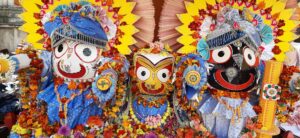Navratri, which literally translates to “nine nights,” is a Hindu festival that is celebrated over nine days to honor the divine feminine energy in the form of Goddess Durga. 9 Days of Navratri Devi Names: The festival is observed twice a year – once in the spring (Chaitra Navratri) and once in the fall (Sharad Navratri).
During Navratri, devotees worship nine forms of the Goddess, each of which represents a different facet of her power and personality. These nine forms are collectively known as the Navadurga or the nine incarnations of Durga. In this blog, we will explore the significance and symbolism behind each of these nine forms.
9 Days of Navratri Devi Names
Day 1: Shailputri Devi
The first day of Navratri is dedicated to Shailputri, who is also known as Parvati or Hemavati. She is the daughter of the Himalayas and is depicted riding a bull. She holds a trident in one hand and a lotus in the other. Shailputri is associated with strength, courage, and determination.
Day 2: Brahmacharini Devi
The second day of Navratri is dedicated to Brahmacharini, who is the embodiment of devotion and spirituality. She is depicted as a young woman dressed in white, carrying a japa mala (prayer beads) and a kamandalu (water pot). She is believed to be an ascetic who meditated for years to attain Lord Shiva as her husband.
Day 3: Chandraghanta Devi
The third day of Navratri is dedicated to Chandraghanta, who is depicted as a fierce warrior riding a tiger. She has ten arms, each holding a weapon or a symbol of power. Her name comes from her half-moon-shaped bell-like ornament on her forehead. Chandraghanta represents bravery and courage.
Day 4: Kushmanda Devi
The fourth day of Navratri is dedicated to Kushmanda, who is believed to have created the universe with her smile. She is depicted as a glowing, radiant figure with eight arms, holding weapons, and a rosary. Her name means “the one who has the power to create the universe.”
Day 5: Skandamata Devi
The fifth day of Navratri is dedicated to Skandamata, who is depicted as a motherly figure holding her son Skanda (also known as Kartikeya) on her lap. She has four arms, with two holding lotuses, one holding Skanda, and the other holding a bell. Skandamata is the symbol of motherly love and nurturing.
Day 6: Katyayani Devi
The sixth day of Navratri is dedicated to Katyayani, who is believed to have been born to Sage Katyayana. She is depicted as a warrior goddess with four arms, holding weapons and a lotus. Her name comes from her father’s name, and she is associated with courage and valor.
Day 7: Kalaratri Devi
The seventh day of Navratri is dedicated to Kalaratri, who is the fiercest form of the Goddess. She is depicted as a dark-skinned woman with long hair, wearing a garland of skulls and holding a sword and a severed head. Kalaratri represents destruction and the power to overcome darkness.
Day 8: Mahagauri Devi
The eighth day of Navratri is dedicated to Mahagauri, who is depicted as a young woman dressed in white, holding a trident and a tambourine. She is the embodiment of purity and is believed to have meditated for years to attain Lord Shiva as her husband. Her name means “extremely white,” symbolizing purity and innocence.
Day 9: Siddhidatri Devi
The ninth and final day of Navratri is dedicated to Siddhidatri, who is depicted as a four-armed goddess holding a mace, a discus, a lotus, and a conch shell. She is the bestower of supernatural powers and represents the culmination of the Navadurga. Devotees believe that by worshipping Siddhidatri, one can attain spiritual enlightenment and liberation.
In addition to their individual symbolism, each of the nine forms of the Goddess also represents a particular day of Navratri. During these nine days, devotees fast, meditate, and offer prayers to the respective forms of the Goddess. The festival concludes on the tenth day, which is celebrated as Vijayadashami or Dussehra, symbolizing the victory of good over evil.
9 Days of Navratri Devi Names: Navratri is a time for spiritual reflection and devotion to the divine feminine energy. It is an opportunity to connect with the Goddess and seek her blessings for strength, courage, and prosperity. The nine forms of the Goddess remind us of the different facets of her power and the qualities that we can cultivate within ourselves to overcome challenges and achieve our goals.
The Bottom Line
Navratri is a significant festival in Hinduism that celebrates the divine feminine energy in the form of Goddess Durga. The nine forms of the Goddess represent different aspects of her power and personality, and each day of Navratri is dedicated to worshipping a specific form. Through devotion and prayer, devotees seek the blessings of the Goddess for strength, courage, and prosperity. Navratri is a time for spiritual reflection and the cultivation of positive qualities within oneself, and it reminds us of the triumph of good over evil.
Happy Navratri🙏



